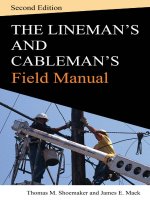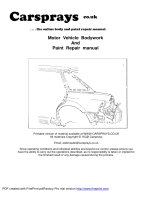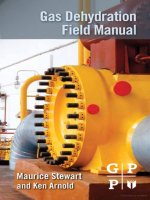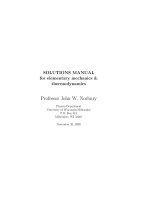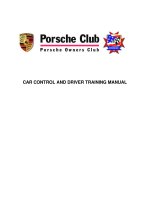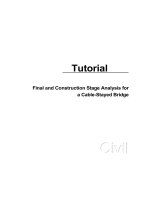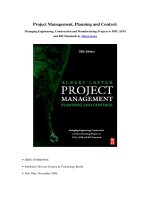pipeline planning and construction field manual
Bạn đang xem bản rút gọn của tài liệu. Xem và tải ngay bản đầy đủ của tài liệu tại đây (5.31 MB, 577 trang )
Pipeline Planning and Construction
Field Manual
This page intentionally left blank
Pipeline Planning and
Construction Field
Manual
E. Shashi Menon, Ph.D., P.E.
SYSTEK Technologies, Inc.
AMSTERDAM • BOSTON • HEIDELBERG • LONDON
NEW YORK • OXFORD • PARIS • SAN DIEGO
SAN FRANCISCO • SINGAPORE • SYDNEY • TOKYO
Gulf Professional Publishing is an imprint of Elsevier
Gulf Professional Publishing is an imprint of Elsevier
225 Wyman Street, Waltham, MA 02451, USA
The Boulevard, Langford Lane, Kidlington, Oxford, OX5 1GB, UK
© 2011 Elsevier Inc. All rights reserved.
No part of this publication may be reproduced or transmitted in any form or by any means,
electronic or mechanical, including photocopying, recording, or any information storage and
retrieval system, without permission in writing from the publisher. Details on how to seek
permission, further information about the Publisher’s permissions policies and our arrangements
with organizations such as the Copyright Clearance Center and the Copyright Licensing Agency,
can be found at our website: www.elsevier.com/permissions.
This book and the individual contributions contained in it are protected under copyright by the
Publisher (other than as may be noted herein).
Notices
Knowledge and best practice in this field are constantly changing. As new research and experience
broaden our understanding, changes in research methods, professional practices, or medical
treatment may become necessary.
Practitioners and researchers must always rely on their own experience and knowledge in evaluating
and using any information, methods, compounds, or experiments described herein. In using such
information or methods they should be mindful of their own safety and the safety of others,
including parties for whom they have a professional responsibility.
To the fullest extent of the law, neither the Publisher nor the authors, contributors, or editors, assume
any liability for any injury and/or damage to persons or property as a matter of products liability,
negligence or otherwise, or from any use or operation of any methods, products, instructions, or
ideas contained in the material herein.
Library of Congress Cataloging-in-Publication Data
Pipeline planning and construction field manual / [edited by] E. Shashi Menon, Ph.D., P.E.
p. cm.
Includes index.
ISBN 978-0-12-383867-4
1. Pipelines. I. Menon, E. Shashi.
TA660.P55P575 2011
621.8'672–dc22 2010052967
British Library Cataloguing-in-Publication Data
A catalogue record for this book is available from the British Library.
For information on all Gulf Professional Publishing publications
visit our Web site at www.elsevierdirect.com
Typeset by: diacriTech, Chennai, India
Printed in the United States of America
11 12 13 14 15 16 10 9 8 7 6 5 4 3 2 1
Contents
List of Contributors xvii
Author Biography xix
Preface xxi
1. Design Basis
E. Shashi Menon, Ph.D., P.E.
Introduction 1
1.1 Units of Measurement 2
1.1.1 Base Units 2
1.1.2 Supplementary Units 3
1.1.3 Derived Units 3
1.2 Physical Properties of Liquids and Gases 4
1.2.1 Liquid Properties 5
1.2.2 Gas Properties 19
Summary 40
Bibliography 41
2. Route Selection
Hal S. Ozanne
Introduction 43
2.1 Community and Local Agencies 45
2.2 Population Density 45
2.2.1 Subpart A: General 46
2.3 Technical and Project Necessities 46
2.4 Constructibility 47
2.5 Right-of-Way 48
2.6 Environmental Issues 49
2.7 Route Beginning and Ending Points 50
2.8 Connections 50
2.9 Mapping System 50
2.10 Field Review 51
2.11 Parallel Other Lines 52
2.12 Integrity 53
2.13 Established Corridors 53
Bibliography 56
v
3. Pipeline Regulatory and Environmental Permits
William E. Bauer
Introduction 57
3.1 Regulation of Interstate Pipelines 58
3.1.1 FERC-Regulated Natural Gas Pipelines 58
3.1.2 FERC-Regulated Oil Pipelines 59
3.1.3 Safety Regulations of Oil, Gas, and Hazardous Materials
Pipelines 59
3.2 Regulation of Intrastate Pipelines 59
3.3 Environmental Permits for Interstate Pipelines 60
3.4 Environmental Permits for Intrastate Pipelines 61
3.5 Local Permits 62
3.5.1 Identifying Permits and Determining Requirements
along a Proposed Linear Facility 63
4. Right-of-Way
William E. Bauer
Introduction 67
4.1 Right-of-Way Deliverables and Requirements 67
4.1.1 Right-of-Way Deliverables 68
4.1.2 Right-of-Way Requirements 69
4.2 Project Planning 69
4.3 Right-of-Way Budgeting 70
4.4 Right-of-Way Database and Records 71
4.4.1 Right-of-Way Database 71
4.4.2 Land Title Research 73
4.4.3 Right-of-Way Documents 74
4.5 Field Support 75
4.6 Right-of-Way Negotiations and Condemnation 75
4.6.1 Negotiations 75
4.6.2 Condemnation Through the Power of Eminent Domain
(Provided the Project Qualifies) 76
4.7 Construction Support 77
4.8 Project Completion and Pipeline Operations 78
4.8.1 Project Completion 78
4.8.2 Pipeline Operations 78
5. Alignment Sheets
Hal S. Ozanne
Introduction 81
5.1 Uses 81
5.2 Alignment Sheet Development 83
5.3 Quantity of Alignment Sheets 84
Contentsvi
5.4 Stationing 84
5.5 Survey 84
5.6 Drawing Issuance 86
5.7 Changes to the Route 86
5.8 Federal Energy Regulatory Commission (FERC) Requirements 90
5.9 Existing Systems 90
Bibliography 92
6. Overview of Pipeline Materials
Hal S. Ozanne
Introduction 93
6.1 Criteria 93
6.2 Product to Be Transported 94
6.3 Operating Pressure 94
6.4 Operating Temperature 94
6.5 Handling and Welding 95
6.6 Volume or Throughput 95
6.7 Codes and Regulations 96
6.7.1 Gas Pipelines 96
6.7.2 Hazardous Liquid Pipelines 100
6.8 Coating 102
6.9 Joint Coating 102
6.10 Fittings 102
Bibliography 103
7. Pipe Strength and Wall Thickness
E. Shashi Menon, Ph.D., P.E.
Introduction 105
7.1 Allowable Operating Pressure 106
7.2 Barlow’s Equation for Internal Pressure 108
7.3 Derivation of Barlow’s Equation 109
7.4 Modified Barlow’s Equation 110
7.5 Gas Pipelines: Class Locations 112
7.5.1 Class 1 112
7.5.2 Class 2 112
7.5.3 Class 3 113
7.5.4 Class 4 113
7.6 Thick-Walled Pipes 114
7.7 Mainline Valves 116
7.8 Blowdown Calculations 116
7.9 Determining Pipe Tonnage 117
Summary 120
Bibliography 121
Contents vii
8. Pipeline Hydraulic Analysis
E. Shashi Menon, Ph.D., P.E.
Introduction 123
8.1 Velocity of Flow in Liquid Pipelines 124
8.2 Reynolds Number in Liquid Flow 127
8.3 Pressure and Head of a Liquid 131
8.4 Pressure Drop in Liquid Flow 133
8.5 Friction Factor 135
8.6 Colebrook–White Equation 137
8.7 Moody Diagram 138
8.8 Hazen–Williams Equation 141
8.9 Minor Losses 151
8.10 Flow of Gas in Pipelines 153
8.11 Erosional Velocity 158
8.12 Reynolds Number in Gas Flow 160
8.13 Friction Factor in Gas Flow 163
8.14 Colebrook–White Equation for Gas Flow 164
8.15 Transmission Factor 165
8.16 Pressure Drop in Gas Flow 168
8.17 Effect of Pipe Elevations 171
8.18 The Average Gas Pressure 172
Summary 174
Bibliography 175
9. Series and Parallel Piping and Power Required
E. Shashi Menon, Ph.D., P.E.
Introduction 177
9.1 Total Pressure Required to Transport Liquids 178
9.2 Hydraulic Pressure Gradient in Liquids 181
9.3 Series Piping in Liquid Pipelines 185
9.4 Parallel Piping in Liquid Pipelines 187
9.5 Transporting High Vapor Pressure Liquids 190
9.6 Pumping Power Required in Liquid Pipelines 190
9.6.1 Hydraulic Horsepower 190
9.6.2 Brake Horsepower 192
9.7 System Head Curves – Liquid Pipelines 193
9.8 Injections and Deliveries – Liquid Pipelines 196
9.9 Pipe Loops in Liquid Pipelines 197
9.10 Gas Pipelines 198
9.10.1 Total Pressure Required to Transport Gases 198
9.11 Hydraulic Pressure Gradient in Gas Pipeline 199
9.12 Series Piping in Gas Pipelines 200
9.13 Parallel Piping in Gas Pipelines 201
Summary 203
Bibliography 204
Contentsviii
10. Valve Stations
Barry G. Bubar, P.E.
Introduction 205
10.1 What to Expect 206
10.2 Valve Usage 206
10.3 Some Other Valves Not Listed by API-6D 210
10.4 Valve Pressure Class 211
10.5 Pipeline Design and Valve Selection 211
10.6 Mainline Valve Locations 212
10.7 Valve Station Design 212
10.8 Buried Valve Vaults 214
10.9 Direct Burial of Valves 216
10.10 Natural Gas Pipeline Valves 216
10.11 Valve Placement on Gas Pipelines 217
10.12 Block Valve Spacing on Gas Transmission Lines 217
10.13 Valve Maintenance for Liquid and Gas Pipelines
as per Code 218
10.13.1 Hazardous Liquid Pipeline Valves 218
10.14 Overpressure Safety Valves and Pressure Limiting Devices
for Hazardous Liquid Pipelines 218
10.15 Natural Gas Pipeline Valves Maintenance 219
10.16 Pressure Limiting and Regulating Stations for Gas Pipelines 219
10.17 General Valve Station Protection 219
10.18 Pipeline Valve Selection – Ball or Gate? 219
References 222
Bibliography 222
11. Pump Stations
E. Shashi Menon, Ph.D., P.E.
Introduction 223
11.1 Multipump Station Pipelines 224
11.2 Hydraulic Balance and Pump Stations Required 224
11.3 Telescoping Pipe Wall Thickness 228
11.4 Change of Pipe Grade – Grade Tapering 229
11.5 Slack Line and Open Channel Flow 229
11.6 Batching Different Liquids 230
11.7 Centrifugal Pumps Versus Reciprocating Pumps 232
11.8 Centrifugal Pump Head and Efficiency Versus Flow Rate 236
11.9 BHP Versus Flow Rate 239
11.10 NPSH Versus Flow Rate 240
11.11 Specific Speed 241
11.12 Affinity Laws for Centrifugal Pumps 242
11.13 Effect of Specific Gravity and Viscosity on Pump
Performance 244
11.14 Pump Configuration – Series and Parallel 246
11.15 Pump Head Curve Versus System Head Curve 249
Contents ix
11.16 Multiple Pumps Versus System Head Curve 250
11.17 NPSH Required Versus NPSH Available 250
11.18 Pump Station Configuration 253
11.19 Control Pressure and Throttle Pressure 254
11.20 Variable Speed Pumps 255
11.21 VSD Pump Versus Control Valve 255
Summary 258
Bibliography 258
12. Compressor Stations
E. Shashi Menon, Ph.D., P.E.
Introduction 259
12.1 Compressor Station Locations 260
12.2 Hydraulic Balance 265
12.3 Isothermal Compression 266
12.4 Adiabatic Compression 268
12.5 Polytropic Compression 270
12.6 Discharge Temperature of Compressed Gas 271
12.7 Compression Power Required 272
12.8 Optimum Compressor Locations 276
12.9 Compressors in Series and Parallel 281
12.10 Types of Compressors – Centrifugal and Positive
Displacement 284
12.11 Compressor Performance Curves 286
12.12 Compressor Head and Gas Flow Rate 288
12.13 Compressor Station Piping Losses 288
12.14 Compressor Station Schematic 290
Summary 291
Bibliography 291
13. Corrosion Protection
E. Shashi Menon, Ph.D., P.E.
Introduction 293
13.1 Corrosion in Pipelines 293
13.2 Causes of Pipeline Failure 294
13.3 Types of Corrosion 297
13.3.1 General Attack Corrosion 297
13.3.2 Localized Corrosion 297
13.3.3 Galvanic Corrosion 299
13.3.4 Environmental Cracking 299
13.3.5 Flow-Assisted Corrosion 300
13.3.6 Intergranular Corrosion 300
13.3.7 Dealloying 300
13.3.8 Fretting Corrosion 300
13.3.9 High-Temperature Corrosion 300
Contentsx
13.4 Corrosion Control 300
13.4.1 Protective Coatings 301
13.4.2 Cathodic Protection (CP) 301
13.4.3 Materials Selection and Design 303
13.4.4 Corrosion Inhibitors 304
Summary 304
Bibliography 304
14. Leak Detection
Hal S. Ozanne
Introduction 305
14.1 Prevention 307
14.2 Pressure Regulation 307
14.3 Cathodic Protection 308
14.4 Corrosion Coupons 308
14.5 Pipeline Markers 308
14.5.1 Markers 308
14.5.2 Aerial Markers 310
14.5.3 Water Crossing Markers 311
14.6 Smart Pigging 311
14.7 Pipeline Security 312
14.8 Regulations 312
14.9 Purpose 313
14.10 Intermediate Block Valves 314
14.11 Check Valves 315
14.12 Patrolling 315
14.13 Detection 315
14.14 Measurement 316
14.15 Supervisory Control and Data Acquisition System 316
14.16 Hydrostatic Testing 317
Bibliography 318
15. Pipeline Pigging and Inspection
Barry G. Bubar, P.E.
Introduction 319
15.1 Pig Use 320
15.2 Pipeline Pigging 320
15.3 Problem Pipelines 321
15.4 Piggable Pipelines 322
15.5 Pig Propulsion 323
15.6 Utility Pigs 324
15.7 Selecting Pigs for Small Bore and Double Diameter Pipelines 326
15.8 Poly Pigs 327
15.9 My First Experience with Poly Pigs 328
15.10 Pig Trains 328
15.11 Smart Pigs 329
Contents xi
15.12 Smart Pig Types 330
15.13 Crack Detection 332
15.14 Preparation for Smart Pig Inspection 332
15.15 MFL Smart Pig 333
15.16 Post Smart Pig Insp ection 335
15.17 Expert Data Evaluation 335
15.18 External Corrosion 336
15.19 Internal Corrosion 337
15.20 Postinspection Criteria 338
Summary 338
References 339
Bibliography 339
16. Pipeline Construction
Glenn A. Wininger
Introduction 341
16.1 Pipeline Construction Sequence 342
16.1.1 Clearing and Grading Crew 343
16.1.2 Soil Classifications and Considerations 347
16.1.3 Trenching Crew 348
16.1.4 Stringing Crew 350
16.1.5 Bending Crew 350
16.1.6 Pipe Gang and Firing Line Welders 351
16.1.7 Coating Crew 351
16.1.8 Lowering-In Crew 352
16.1.9 Backfill Crew 352
16.1.10 Tie-In Crew 353
16.1.11 Testing Crew 353
16.1.12 Clean-Up Crew 354
16.2 Restoration of Disturbed Construction R.O.W. 355
17. Welding and NDT
Barry G. Bubar, P.E.
Introduction 357
17.1 Pipeline Welding Procedures 358
17.2 Specimen Preparation 359
17.3 Testing 359
17.4 Criteria for Weld Acceptance 359
17.5 Classic Pipeline Welding 361
17.6 Double Joints 362
17.7 Using Higher X-Grade Pipe 364
17.8 Welders’ Qualification 366
17.9 Welders’ Responsibility 367
17.10 Automatic Pipeline Welding 368
17.11 Verifying Automatic Weld Integrity 370
17.12 Semiautomatic Welding 370
Contentsxii
17.13 Strength of Welded Pipelines 372
17.14 Nondestructive Testing of Pipe Girth Welds 373
17.15 Radiographic NDT 374
17.16 Repair of Defect 374
17.17 Welding Rejection Criteria 374
References 377
Bibliography 378
18. Hydrostatic Testing
Barry G. Bubar, P.E.
Introduction, Including Risk-Based Alternatives to Testing 379
18.1 Testing Pipe 382
18.2 Classifying in Service Pipelines 383
18.3 Intrastate Pipelines 383
18.4 Pretest Planning for an Intrastate Pipeline 384
18.5 Test Water Disposal 389
18.6 Safety and Equipment Procedures During Test 389
18.7 Turning and Operating Valves 389
18.8 Training and Judgment 389
18.9 Back to Test Procedure 390
18.10 Pressurization 391
18.11 List of Equipment for Hydrostatic Test 392
18.12 Test On 393
18.13 Posttest Results 393
18.14 Posttest Leak Analysis 394
18.15 Entrained Air and Vapor 396
18.16 Leaking Isolation Valves and Fittings 396
18.17 Changing Test Water Temperature 397
18.18 Posttest Report 397
18.19 Volume Analysis 397
18.20 Testing Interstate Liquid and Natural Gas Transmissions Lines 398
18.21 Test Section 12 401
18.22 Cross-Country Pipeline Testing 402
18.23 Pipeline Rupture 402
References 404
19. Commissioning
Hal S. Ozanne
Introduction 405
19.1 Plan 411
19.2 Plan Sequence 411
19.3 Operations and Maintenance Manuals 412
19.4 Completion of Construction 412
19.5 Sizing or Gauging Pigs 412
19.6 System Checkout 413
Contents xiii
19.7 Pipeline Drying 413
19.8 Line Fill 414
19.8.1 Example 414
Bibliography 420
20. Specification Writing, Data Sheet Production,
Requisition Development, and Bid Analysis
Glenn A. Wininger
Introduction 421
20.1 Specification Writing 421
20.2 Material Specifications 422
20.2.1 Pipe 422
20.2.2 External Coating of Line Pipe 425
20.2.3 Fittings, Valves, and Components 435
20.2.4 Induction Bends 435
20.3 Construction Specifications 438
20.4 Material Requisition Development 461
20.5 Bid Quotation and Bid Analysis 461
20.5.1 Bid Quotation 461
20.5.2 Bid Analysis and Evaluation 463
21. Operations and Maintenance Manuals
Hal S. Ozanne
Introduction 466
21.1 Operating Manuals 466
21.2 Regulations 466
21.3 Written Emergency Procedures 467
21.4 Training Program 468
21.5 Details 474
21.5.1 Operating Pressures 474
21.5.2 Communications 474
21.5.3 Line Location and Markers 474
21.5.4 ROW Maintenance 474
21.5.5 Patrolling 475
21.5.6 Integrity Assessments and Repair 475
21.5.7 Pump Station, Terminal, and Tank Farm
Maintenance and Operations 475
21.5.8 Controls and Protective Equipment 476
21.5.9 Storage Vessels 476
21.5.10 Fencing 476
21.5.11 Signs 476
21.5.12 Prevention of Accidental Ignition 476
21.5.13 Corrosion Control 477
21.5.14 Emergency Plan 477
21.5.15 Records 477
21.5.16 Training 478
21.5.17 Modification to Plans 478
Contentsxiv
21.6 Maintenance Manuals 478
21.7 Preventative Maintenance 478
21.8 Project Data Book 478
21.9 Startup Sequential Process 481
21.10 Shutdown Sequential Process 481
Bibliography 482
Appendix 1 483
Appendix 2 495
Appendix 3 501
Appendix 4 517
Appendix 5 523
Appendix 6 533
Appendix 7 537
Appendix 8 541
Appendix 9 545
Index 549
Contents xv
This page intentionally left blank
List of Contributors
E. Shashi Menon, Ph.D., P.E.
William E. Bauer
Barry G. Bubar, P.E.
Hal S. Ozanne
Glenn A. Wininger
xvii
This page intentionally left blank
Author Biography
E. Shashi Menon, Ph.D., P.E.
E. Shashi Menon is the vice president of SYSTEK Technologies, Inc. in Lake
Havasu City, Arizona, USA. He has worked in the oil and gas and manufactur-
ing industry for over 37 years. He held positions of design engineer, project
engineer, engineering manager, and chief engineer with major oil and gas com-
panies in the United States. He has authored four technical books for major pub-
lishers and coauthored over a dozen engineering software applications. He
conducts training workshops in liquid and gas pipeline hydraulics at various
locations in the United States and South America.
Barry G. Bubar, P.E.
Barry Buba r graduated from University o f Califo rnia w ith a BS degree in
mecha nical engineering. He has worked in the petroleum pipeline industry as
a district engineer, project engineer and staff engineer and has ov er 3 5 years
experience in oil, gas, and power companies. He has taught classes in pipeline
hydraulics and pipeline welding and now works as a mechanical engineering
consultant.
William E. Bauer
Bill Bauer has be en associated with right-of-way acquisition projects for over
35 years. He has managed the acquisition of pipeline rights-of-way, regulatory
permits, and associated actions throughout the continental United States,
Alaska, Europe, and Russia. He is a graduate of Lamar University, Beaumont,
Texas, with a BS degree in Math and has written and/or edited numerous books,
articles, and videos relating to right-of-way. He is also a certified instructor for
the International Right-of-Way Association. Bill has seen right-of-way acquisi-
tion move from a hand shake, a signature, and a nominal payment to a highly
technical effort sometimes approaching 25% or more of the total cost of a pipe-
line project.
Hal S. Ozanne
Hal S. Ozanne, BSME, is the vice president of Denver Operations of ENGlobal
Engineering, Inc. in Denver, Colorado, USA.
xix
He has worked in the oil and gas industry for over 42 years. His experience
has included managing a division office for a consulting engineering firm pro-
viding engineering services to the oil and gas industry, serving as project man-
ager for various pipeline projects throughout the United States, and working for
a pipeline operating company in various capacities.
Glenn A. Wininger
Glenn Wininger graduated from Oklahoma State University with a BS degree in
civil engineering in 1984 and a BS degree in biology in 1990 from Ohio State
University. He worked for numerous engineering firms with emphasis in cross-
country pipeline projects and as a consultant for enginee ring firms related to
local area gas distribution companies. He held positions within gas companies
in engineering and construction management, as well as operations. He assisted
companies in compiling data for the Federal Energy Re gulator y C ommitte e
(FERC) applications, as well as providing support for Draft Environmental
Impact Statement (DEIS) and Final Environmental Impact Statement (FEIS)
response related to variou s requ ests. He held a Registered Professional Land
Surveyor (RPLS) license from 1986 to 1990.
Author Biographyxx
Preface
There are thousands of pipelines crisscrossing the globe, both onshore and
offshore. Designing, constructing, and operating these pipelines and their
appurtenant facilities require special skills along with experience. Design
criteria and construction techniques differ from area to area and knowing
where and how to access such criteria is essential for pipeline professionals.
This book was prepared in order to give engineers and technicians a work-
ing knowledge of the processes of planning, designing, and construction of a
pipeline system. The idea for the book was concei ved by Elsevier Senior Acqui-
sitions Editor, Kenneth McCombs, in consultation with Shashi Menon, a pro-
fessional engineer with over 37 years of experience in the US Oil and Gas
industry. In addition, we assembled a team of experts with over 180 years com-
bined experience throughout the United States and the world to collaborate on
the book and produce a relevant and useful reference manual for pipeline plan-
ning and construction.
Chapter 1 covers the design basis that forms the foundation for the design of
pipelines, pump stations, compressor stations, valves, and other facilities that
comprise the pipeline system.
Chapter 2 introduces the various things that must be taken into consideration
in selecting a pipeline route and how a route may be selected and changed as it
is being developed.
Chapter 3 reviews pipeline regulatory and environmental permits. This
includes numerous permits and approvals that must be obtained from state,
federal, and local agencies.
Chapter 4 covers the right-of-way (ROW) aspects including the responsibil-
ity of ROW team to provide the project a continuous constructible strip of land
for the construction of the pipeline and all related surface facilities, including a
continuous pipeline right-of-way, all additional work spaces, surface sites for
compressor stations, pump stations, met ers, valves, and storage sites.
Chapter 5 describes how pipeline alig nment sheets are prepared, the infor-
mation that is included on them and their use.
Chapter 6 is an overview of pipeline materials. The chapter describes how
materials for a pipeline are selected taking into consideration the pipeline service,
operating conditions, and the appropriate regulations that must be followed.
Chapter 7 is a discussion of the strength capabilities of a pipeline that is sub-
ject to internal pressure and how the required pipe wall thickness is calculated.
Chapter 8 explains pipeline hydraulic analysis for both liquid and gas pipe-
line s. The chapter reviews the different types of flow, Re ynold s number, and
xxi
pressu re drop due to friction and determining pumping pressure requirements
and location of pump stations and compressor stations.
Chapter 9 covers the calculation of the pressure required in series and par-
allel piping. In addition, the pumping power required and the number of pumps
or compressor stations needed for a long transmission pipeline are discu ssed.
Chapter 10 reviews requirements of multiple valve stations along a pipeline
necess ary for isolating segments of pipelines for repair work and in case of a
leak, damage, or rupture. In addition, valves installed at pipeline branch connec-
tions for delivery or receipt of product being shipped on the mainline are also
discussed.
Chapter 11 explains the pump stations and pumping configurations in liquid
pipelines along with the optimum locations of pump s tations for hyd raulic
balance. Centrifugal pumps and positive displacement pumps and their perfor-
mance characteristics are reviewed. The use of variable speed pumps to save
pumping power under different operating conditions is also discussed.
Chapter 12 explains the approach to sizing compressor stations in gas pipe-
lines. The optimum locations and pressures at which compressor stations oper-
ate are reviewed. Centrifugal and positive displacement compressors used in
natural gas transportation are compared with reference to their performance
characteristics and cost.
Chapter 13 discusses pipeline corr osion, how corrosion occ urs, and the
method employed to protect liquid and gas pipelines and associated facilities
from corrosion damage.
Chapter 14 introduces the provisions for leak detection for a pipeline. Pipe-
line operators must take the necessary preparations to eliminate or greatly
reduce the possibility of a leak from their system.
Chapter 15 discusses pipeline pigging and internal inspection. Pigging of a
pipeline is essential for effective and efficient operation and maintenance. This
results in increased pipeline efficiency and extends its useful life.
Chapter 16 discusses pipeline construction with reference to federal, state,
district, and local regulations.
Chapter 17 discusses welding and nondestructive testing (NDT) of liquid
and gas pipelines. Pipe welding procedures, double jointing, welder qualifica-
tion, automatic welding, radiography, weld rejection criteria are reviewed.
Chapter 18 discusses hydrostatic test ing to ensure integrity of pipeline in
service. The federal regulations such as CFR Title 49, Part 195 for Hazardous
Liquid Pipelines and CFR Title 49, Part 192 for Gas Pipelines are reviewed.
Chapter 19 describes the preparation and steps to commission or place a
pipeline into operation.
Chapter 20 covers specific ation writing, data sheet product ion, requisition
development, and bid analysis for pipeline materials and equipment.
Chapter 21 describes the inform ation that is included in operations and
maintenance manuals and the preparation of these manuals.
Prefacexxii
The authors would like to acknowledge the many suggestions and
constructive comments received from their peers who reviewed portions of the
manuscript. Special thanks to David W. Sinclair for his assistance in the review
of Chapters 3 and 4 of this manual. Mr. Sinclair, a right-of-way executive for
more than 30 years, has been a strong supporter of education and professionalism
through the International Right of Way Association (IRWA). In addition,
the authors would like to thank their families for being understanding during
the many hours spent w riting, revising, and proofreading the manuscript and
subsequent page proofs.
We would like to take this opportunity to thank Kenneth McCombs, Senior
Acquisitions Editor of Elsevier Publishing, for s uggesting the subject matter
and format for the book. We enjoyed working wi th him, as well as others, at
Elsevier such as Jill Leonard (Editorial Project Manager) and Heather Tighe
(Associate Project Manager).
Authors have exercised care and diligence to contact copyright holders for
permission to use published reference materials. We have also worked hard
to eliminate errors and omissions. Readers are encourag ed to independently
check calculations and verify results prior to using them in their projects. We
welcome notifications of corrections and suggesti ons for improvement of this
field manual in subsequent edition.
E. Shashi Menon
Barry G. Bubar
William E. Bauer
Hal S. Ozanne
Glenn A. Wininger
Preface xxiii
This page intentionally left blank


